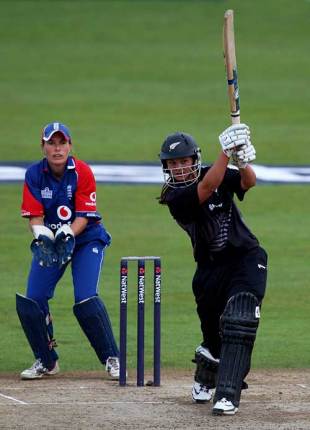
|

Attractive talents such as New Zealand's Suzie Bates could shine in front of huge audiences
© Getty Images
|
|
Women are great innovators in cricket. They played the first Twenty20, ahead of the men. They thought of the first World Cup, in 1972. Some say a woman, Christina Willes, even thought up overarm bowling. In some ways it's a surprise, then, that they didn't beat the men to the World Twenty20.
But now they have their well-deserved chance to shine in the limelight as
the ICC has confirmed to Cricinfo that, subject to budget approval, the women will have a World Twenty20 scheduled around the men's at the next tournament in England in 2009. The championship could do even more for the women than what it has for the men: much, much more, as the game could be on television every day throughout the tournament, meaning increased exposure and sponsorship.
Women cricketers' achievements have gone largely unnoticed over the years, bar the occasional televised match, and precious few are still household names. This, though, is the game's chance to burst into the awareness of the general public, and comes on the back of the largely excellent work of the ICC in bringing together the men's and women's boards around the world, while working towards making the game more professional. Some boards had already merged before the ICC took over the women's game. The ECB, for example, had already instigated funding, unified the administrations, and had the same kit for women and men, but with the world merger the game has had many more opportunities, of which this is the biggest yet.
While some may question whether the women's version is attractive enough to be on television, the game has improved immeasurably, with power-hitting, playing over the top - as demonstrated by New Zealand's Suzie Bates and England's Sarah Taylor - and 70mph-plus fast bowling from such players as Jhulan Goswami of India and Australia's Emma Sampson.
The women's game has always been big on technical accuracy, but has often been a comparatively dull affair, with 200 a winning score in 50-over games. These days it has the attractive, fast-paced element to match, although it cannot hope to match men's cricket, and it is better than it is often given credit for. Nevertheless, exposure had remained a challenge. Until now.
The game will have to wait until early 2008 to hear if budget approval has been given, but if and when it is, it would be welcome news for a sport that is often overlooked despite abundant talent. The story is the same from women's cricket colonies around the world: whenever spectators attend their first match, they are surprised and impressed.
It's one of the sport's best-kept secrets.
Twenty20 in particular lends itself to the new women's game. As with the men's version, it's a short enough injection while still providing a chance for the display of manifest skills. The women's game is also a family-friendly arena, and the players are highly accessible, making it an attractive proposition for young autograph hunters.
One challenge at the World Twenty20 would be for the second tier of women's teams - including South Africa, Pakistan, West Indies - to put on a show worth watching. The experiment to have the Afro-Asia women's tournament as a curtain raiser to the men's last June was hardly a great advertisement - the teams made
105 and 45. But other domestic experiments in England and Australia, where women's teams played ahead of domestic and state men's matches, succeeded in showing off the skills in exciting games.
And, thankfully, the competition offered by the second level on the world stage should at least be more than that on offer at the Afro-Asia tournament. South Africa's captain Cri-zelda Brits believes her side would put on a good show. She watched England and New Zealand entertain during a Twenty20 over summer and told Cricinfo in August: "Just watching these two teams and how they've excelled in that form really is proof that we could all participate in such an event, and I'm sure you'll see the gap closing between nations participating in these sort of games."
The ICC, along with the boards, must be applauded for their thinking. They have the clout, the money and the exposure, and most crucially, they are putting their mouth where their money is and making great strides.
At a time when they face criticism for scheduling too many matches in the men's game, they have hardly burdened the women's game the same way. Women's cricket offers them a largely untapped market, one with much potential for growth among women and young fans, and this latest plan could hopefully help reach out to those audiences.
The ICC showed they could put on an excellent show in the first World Twenty20, and the format breathed new life into the game. Now with the women's game they are on the cusp of turning the lick of flame into a burning fire that could at last set the public's imaginations alight.
Jenny Thompson is an assistant editor at Cricinfo

